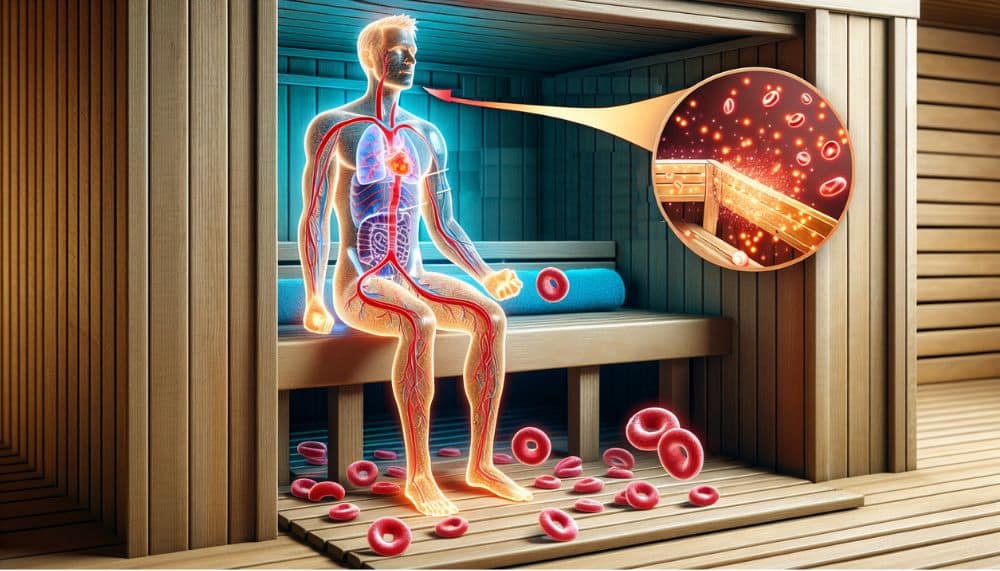Seeking faster recovery post-workout? Sauna use effectively eases muscle soreness, accelerates muscle repair, and decreases inflammation, making it a valuable addition to your recovery routine. Read on to explore the science behind sauna for recovery and practical tips for safe and effective use.
- Key Takeaways
- The Healing Heat: How Saunas Enhance Post-Workout Recovery
- The Cardiovascular Advantages of Sauna Post Workout
- Infrared Saunas: Targeted Recovery for Athletes
- Integrating Sauna Into Your Workout Routine
- Precautions and Considerations for Sauna Use After Exercise
- Enhancing Wellness Beyond Recovery: Additional Sauna Benefits
- Summary
- Frequently Asked Questions
Key Takeaways
- Sauna use after workouts improves circulation and reduces muscle soreness.
- Regular post-exercise sauna sessions improve cardiovascular health by reducing heart disease risk, regulating blood pressure, and improving vascular health through nitric oxide production, potentially leading to gains in cardiovascular fitness similar to moderate-intensity workouts.
- Infrared saunas offer targeted recovery for athletes by penetrating muscle tissue at a cellular level, inducing vasodilation for improved blood circulation, and aiding neuromuscular recovery, with the added benefit of improved mood.
The Healing Heat: How Saunas Enhance Post-Workout Recovery

Entering the sauna after an intense workout goes beyond relaxation. It’s a science-supported method to expedite your return to optimum performance. Think of the post-workout sauna as a sanctuary where the heat envelops your body, enhancing the circulation of oxygen and nutrient-rich blood throughout every fibre of your being.
This physiological phenomenon carries the life-giving forces to tired muscles, allowing them to unwind and begin the healing process. Incorporating a sauna after a workout thus emerges as a useful tool, not only diminishing post-workout muscle soreness but also accelerating the overall recovery process, allowing you to push the boundaries of your physical limits once more.
Accelerating Muscle Repair with Sauna Heat
The sauna’s heat is a catalyst for muscle repair. The heat encourages circulation, which is like dispatching a fleet of nutrient-rich blood vessels to the zones most depleted by physical exertion.
Using a sauna after exercising is not just a luxury. It’s a science-backed method for boosting muscle recovery by delivering oxygen-enriched blood to overworked muscles and hastening the repair process.
Easing Muscle Aches Through Thermal Therapy
Saunas offer a thermal therapy that eases muscle aches and promotes relaxation more effectively than many other methods. After an intense workout, stepping into the sauna can feel like a therapeutic embrace, with the heat working to relax muscles, increase blood flow, reduce joint tension, and soothe sore muscles.
Infrared saunas, in particular, are athletes’ favourites, making muscles more pliable and easier to stretch, thus improving recovery and range of motion. There are high and low EMF infrared saunas. Learn about the benefits of a low infrared sauna.
Sauna Sessions and the Reduction of Inflammation

Saunas are havens for inflamed tissues. They aid in reducing inflammation by improving circulation and facilitating the release of anti-inflammatory compounds. Following a workout, sauna sessions provide a sanctuary where the increased blood flow swiftly delivers oxygen-rich blood to muscles, helping alleviate muscle soreness and contributing to a more rapid recovery.
The Cardiovascular Advantages of Sauna Post Workout
The heart reaps its rewards from sauna use following physical exertion. Regular post-exercise sauna sessions offer:
- A reduction in the risk of heart disease
- Improvements in blood pressure regulation
- Notable gains in cardiovascular fitness, akin to the benefits derived from moderate-intensity cardio workouts1
Engaging in sauna bathing three times a week can lead to these benefits.
Maximal oxygen uptake, an essential gauge of cardiovascular health, also sees improvement, while the heart and blood vessels enjoy a potent health boost beyond what exercise alone can provide.
Strengthening Heart Health with Regular Sauna Use
The path to a robust heart may very well be paved with regular sauna sessions. Routine sauna use can:
- Dramatically reduce the likelihood of death from heart-related conditions
- Play a role in regulating blood pressure
- Foster healthier blood vessels
- Enhance Heart Rate Variability (HRV), which is indicative of a more resilient cardiovascular system.
Boosting Blood Vessels’ Health Post-Exercise
Using the sauna after exercising is more than a delight; it’s a benefit to your vascular health, enhancing blood vessel health by promoting the production of nitric oxide, which enables them to widen and improve blood flow.
Regular sauna bathing is also associated with a decreased risk of atherosclerosis, ensuring the arteries remain free of obstructive buildups and capable of efficiently delivering oxygen and nutrients to the body after strenuous activity2.
Infrared Saunas: Targeted Recovery for Athletes
Infrared saunas specialise in targeted recovery, particularly after strength and endurance training sessions. The deep penetration of infrared heat aids the neuromuscular system by improving circulation and promoting relaxation. An infrared sauna session can be a great addition to your recovery routine.
This advanced technology ensures that athletes recover more quickly post-exercise, as the increased blood flow delivers oxygen and nutrients to muscles, speeding up recovery time and reducing the risk of injury.
Enhanced Muscle Function with Infrared Technology
Infrared technology is a game-changer for muscle function. It reaches muscle tissue at a cellular level, inducing vasodilation of capillaries for improved blood circulation which is vital for neuromuscular recovery. Athletes report the following benefits:
- Improved muscle condition
- Enhanced mood
- Readiness for subsequent performance
- Significant improvements in measures like lower body power
Integrating Sauna Into Your Workout Routine
Including sauna sessions in your workout routine necessitates careful attention and respect for your body’s boundaries. After a light workout, the sauna can be a comforting finale for up to 15 minutes, while following intense workouts, a shorter stay of no more than 10 minutes is advised for aiding recovery.
Start with brief sessions and incrementally increase the duration each week, always ensuring that you stay well-hydrated throughout the process.
Gym Sauna Etiquette and Best Practices

Navigating the gym sauna etiquette is straightforward yet essential. Here are some guidelines to follow:
- Begin with a shower to cleanse away any post-workout residue.
- Dress modestly with a towel or bathing suit.
- Leave your electronics behind to maintain a serene atmosphere for everyone.
Remember that the traditional sauna and steam rooms are places for communal relaxation and recovery, not for continuing your workout.
Timing Your Sauna Session for Optimal Recovery
Effective scheduling is paramount for optimising the recovery benefits of your sauna session. Starting with sessions of 5 to 10 minutes and gradually increasing the duration up to a maximum of 15-20 minutes can help to ensure a safe and effective recovery process. Adequate hydration is vital to avoid dehydration and overheating, especially considering the enhanced cardiorespiratory fitness, blood pressure regulation, and cholesterol level improvements that come with a regular post-exercise sauna routine.
Precautions and Considerations for Sauna Use After Exercise
Despite the substantial benefits of using a sauna after exercise, it’s crucial to proceed with caution. Hydration is paramount to prevent risks such as dizziness, muscle cramps, and heatstroke.
The period immediately after a workout is when dehydration risks are heightened, so it’s vital to consider this when stepping into the sauna.
Recognising the Signs of Overheating and Dehydration
Being able to recognise the signs of overheating and dehydration can be the difference between a beneficial sauna session and a health risk. Symptoms such as excessive sweating, dizziness, and muscle cramps are tell-tale signs that your body is struggling to cope with the heat. Dark urine and a dry throat are classic indicators of dehydration, and it’s essential to start with shorter sauna intervals, stay well-hydrated, and listen to your body’s signals to prevent these conditions.
Special Considerations for High-Risk Groups
Special considerations must be taken for individuals with pre-existing health conditions. High blood pressure, diabetes, and heart conditions warrant a consultation with a healthcare provider before engaging in sauna use. For those with stable heart conditions, sauna use can be resumed with a doctor’s clearance and adherence to specific guidelines, such as avoiding extreme temperatures and alcohol consumption before and after sauna sessions.
Enhancing Wellness Beyond Recovery: Additional Sauna Benefits
The scope of sauna benefits stretches well beyond physical recovery, touching the realms of mental and holistic well-being. Frequent sauna sessions aid in reducing stress levels and enhancing mental health, which includes alleviating symptoms of anorexia and hyperactivity.
Improved mood, better sleep quality, and even potential reductions in fat mass are some of the health benefits that accompany the use of saunas, offering a comprehensive approach to wellness.
Sauna Use as a Stress Management Technique

Saunas can serve as sanctuaries of stress management, guiding the body towards a state of parasympathetic activity that encourages relaxation and digestion. The hormonal changes, such as increased dopamine, that occur during a sauna session contribute to feelings of calmness and mental clarity, providing an ideal environment for practising stress management techniques like deep breathing.
The Role of Sauna in Holistic Pain Relief Strategies
Sauna therapy is an integral part of holistic pain relief strategies. Its ability to lessen pain intensity in conditions like fibromyalgia, chronic tension-type headaches, and low back pain is backed by scientific studies that show significant reductions in pain after regular use.
The heat from dry saunas reduces pain by stimulating receptors, decreasing oxidative stress, and improving joint motion, all of which contribute to holistic pain management.
Summary
In recovery and wellness, the sauna plays a pivotal role. We’ve journeyed through the multifaceted benefits of sauna use, from accelerating muscle recovery and easing aches to boosting cardiovascular health and enhancing overall well-being.
Remember, the key to reaping these rewards is to integrate sauna sessions thoughtfully into your routine, remain vigilant about hydration, and heed any special considerations for your health. As we’ve seen, the sauna is more than a place of refuge after a gruelling workout; it’s a powerful ally in the quest for optimal performance and balanced life.
Frequently Asked Questions
Is a sauna good for recovery?
Yes, using a sauna after your workout can help reduce muscle soreness by up to 47% just 24 hours after your session, as it opens up your blood vessels and relaxes your muscles, aiding in recovery.
Does sauna help recovery on rest day?
Yes, saunas can help enhance muscle recovery, detoxification, blood flow, and reduce chronic fatigue.
Are saunas good for healing injuries?
Yes, saunas are beneficial for healing injuries as the heat stimulates circulation, reduces inflammation, and helps with swelling and chronic pain.
How long should I stay in the sauna after a workout?
After a light workout, you can stay in the sauna for up to 15 minutes, while after a more intense workout, a maximum of 10 minutes is recommended. Start with shorter sessions and increase the time gradually based on your comfort and hydration levels. See how long should you stay in a sauna safely.
Can sauna use improve cardiovascular health?
Yes, regular post-workout sauna sessions have been linked to significant cardiovascular benefits, including reduced risk of heart disease, improved blood pressure, and enhanced heart health. Regular sauna use can improve cardiovascular health.
- How Long Should You Stay in a Sauna Safely? - 20 January 2024
- Boost Post-Workout Recovery: Benefits of Using a Sauna for Recovery - 19 January 2024
- Discover the Health Benefits of a Low EMF Infrared Sauna - 19 January 2024
